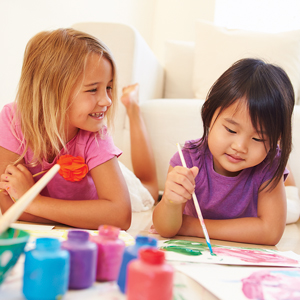As a typical MOB (mom of boys) running a typical home, it’s not unusual to hear a basketball bouncing around in my living room or to stumble barefoot over a half-dozen mini LEGO cities in the middle of the kitchen. My house is just plain noisy with boyhood! My 6- and 8-year-olds love to play and they love to play hard. But while they are active and playful and everything you would expect from two on-the-go little boys, they also can’t live without their chosen handheld devices.
Mom, did you charge my Kindle? the younger one will call out. Brady, did you grab your iPad? the loving mom will inquire. These phrases are also part of everyday interaction at home. They adore their electronics so much that when a tablet is misplaced or damaged, you would think the apocalypse has descended upon our household. It’s not pretty. Our generation of children practically comes out of the womb with an iPad in one hand and an innate ability to text with the other. But with their arms full of gadgets, let’s consider the theory that children may be missing out on one of the most basic components of childhood: real playtime with actual toys.
In our technology-driven world, it’s easy to forget that the basic fundamentals of learning typically start with those little hands-on toys, not iPhones. Rattles, balls, and spoons are sometimes given to a baby to keep him occupied, but these toys ultimately help baby figure out what his world is all about. Once babies grab those first toys, they are learning. Using their hands to touch and explore increases knowledge; effective toys are created to help children learn and develop on a multitude of levels. Whether it is socially, cognitively, or physically, toys and games are what help our children realize how everything around them works.
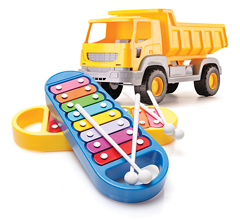 “Play and learning are interchangeable,” says Liz Pearce, director of parent engagement for Commonwealth Parenting at Children’s Museum of Richmond. “When children are physically grasping a toy with their hands, they are learning about the different properties of that object which, fundamentally, helps them learn about the different properties of the world.” So with current technology, children can also learn about the properties of the world from the screen. What’s the difference in building a tower with blocks and creating a tower on a tablet? “It’s so easy to erase and start over when you are using a computer screen,” says Pearce. “But with actual blocks, the risk is higher; you have to really figure out the balance of the items, where the placement should be, what will cause it to fall.”
“Play and learning are interchangeable,” says Liz Pearce, director of parent engagement for Commonwealth Parenting at Children’s Museum of Richmond. “When children are physically grasping a toy with their hands, they are learning about the different properties of that object which, fundamentally, helps them learn about the different properties of the world.” So with current technology, children can also learn about the properties of the world from the screen. What’s the difference in building a tower with blocks and creating a tower on a tablet? “It’s so easy to erase and start over when you are using a computer screen,” says Pearce. “But with actual blocks, the risk is higher; you have to really figure out the balance of the items, where the placement should be, what will cause it to fall.”
It’s funny that she mentions that part, as I’m picturing my sons’ faces when the block tower topples. But according to Liz, the building and the demolition are part of the process. “It’s an experience you (children) are not going to get looking at a screen, and the end result is going to give a child much more satisfaction. Children need toys and games to have fun but they also need them for all of their stages of development.”
Can We Talk? [Language & Social]
Along with experiencing the world, come the lessons of experiencing each other. “Any toy that involves interacting with another child or adult helps promote a child’s social development,” says Pearce, who is certain that important lifelong skills such as taking turns, negotiating, and the virtue of patience are taught through play. Blocks, board games, and playing make-believe are a few of the childhood staples that can help a child grow up to be a functioning member of society.
 Mary Mollen, owner of The Toy Center in Richmond, believes the biggest piece missing from teaching a child social and language development might be the parents themselves. “Many parents want a toy that they can just give a kid to play with so they can go cook dinner or work on the computer or do the other millions of things parents have to do on a given day,” says Mollen. “But parents don’t realize that, sometimes, if you are not sitting with your children and helping them figure out the puzzle or playing a game with them, then how are you modeling for your child how to socialize?” The bottom line, according to Mollen, is that when they can, parents need to be on the floor playing with their children from zero to eighteen months.
Mary Mollen, owner of The Toy Center in Richmond, believes the biggest piece missing from teaching a child social and language development might be the parents themselves. “Many parents want a toy that they can just give a kid to play with so they can go cook dinner or work on the computer or do the other millions of things parents have to do on a given day,” says Mollen. “But parents don’t realize that, sometimes, if you are not sitting with your children and helping them figure out the puzzle or playing a game with them, then how are you modeling for your child how to socialize?” The bottom line, according to Mollen, is that when they can, parents need to be on the floor playing with their children from zero to eighteen months.
When parents are also interacting with their children and with the toys their children are playing with, they are strengthening relationships with their little ones and helping to increase their children’s communication skills. Shiree Parnell, a mother of four, remembers her mom sitting on the floor and playing Barbie dolls with her at a young age. “Even if she had tons of other things she should be doing, my mom always took the time to play dolls with me. It’s one of the fondest memories I have with her,” says Parnell. She remembers that interaction when her own children want her to play with her. “I might just be sitting there talking with them while they play, but they are happy that I am present, not on my cell phone – but paying attention to them.”
Movin’ and Groovin’ [Physical]
An important way for parents to get involved is in encouraging gross motor development. At our house, my boys can turn any game into a physical contest. A simple round of Go Fish might end up as an all-out pillow fight or wrestling match. Pearce believes that from an early age, parents should begin building their children’s gross motor skills by encouraging climbing on safe objects, skipping and hopping using jump ropes, and promoting activities that involve balls. Balls are one of the oldest and most basic toys, but they can help teach our children everything from balance to hand-eye coordination. Pearce tells parents to get on the floor with kids and roll the ball back and forth to your child as soon as they are old enough to do so. Once kids are old enough to run around, play soccer with them, dodgeball, and basketball.
When they get tired of the ball play? “Try parachute play, hula hoops, dancing with scarves, there are so many things!” says Nicole Nelson, director for The Goddard School in Enon. “Play Twister with them, hide-and-go-seek, water guns, anything that will get them physically moving. Just remember to try and be a part of the fun too,” says Nelson, who adds that this kind of active play is a good way for parents to stay in shape too.
Learning is Fun [Cognitive]
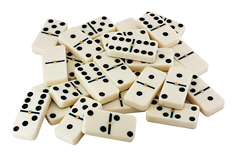 Like a sponge, a child’s brain soaks up everything it can. Playing independently and with toys helps support brain growth and development. For our youngest children, Mollen from the Toy Center suggests any type of toy that has them sequencing or recognizing shapes, colors, and patterns. She likes the Melissa and Doug toy sets.
Like a sponge, a child’s brain soaks up everything it can. Playing independently and with toys helps support brain growth and development. For our youngest children, Mollen from the Toy Center suggests any type of toy that has them sequencing or recognizing shapes, colors, and patterns. She likes the Melissa and Doug toy sets.
For our older children, Pearce of CMoR recommends science experiments. “Any type of activity where your child is estimating, making predictions, and solving problems,” says Pearce. A trip to any toy store can help parents match their kids with these types of activities. The Toy Center stocks several science kits including The Potato Chip Science Book and Stuff by Allen and Max Kurzweil – which might be a collection of the coolest experiments ever. Everyday cooking and making your own Play-Doh at home with the kids is another example of science that’s fun and creative.
Arts and Smarts [Creative]
No matter how much my kids love playing sports, rough-housing, or using their electronics, dress-up and arts and crafts are always high on the list. Mollen finds it encouraging that art is historically the most popular category at The Toy Center. Furthermore, the store owner maintains that art should always be the go-to choice for kids over technology. “Instead of handing them your phone the next time you’re in a restaurant, hand them a notebook and some crayons or Play-Doh or Scratch Art. You don’t always have to reach for the electronics.”
For some parents and caregivers, it might be a habit that’s hard to break, but it’s worth reminding anyone who’s around kids that hands-on play is important. I’ll never forget the rainy day when I pulled out two birdhouses for my two boys to paint. They had been glued to their game console all morning and needed an electronics detox. I definitely earned some super cool mom points that day. My boys spent over an hour making their houses look just right, and they didn’t miss their video games at all.
8 Great Toys for Zero to Eight
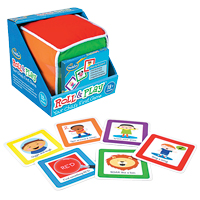 When shopping for toys and activities, it’s important for parents to take some of the products for a test drive. “When a parent gets to interact with a certain toy or game and see how it works…it’s much more powerful than browsing online,” says Mary Mollen of The Toy Center. Plus you get to see how well a toy or game is built (or isn’t!) and if it will hold up once you get it home. Here are some toys that should be on Santa’s radar this year.
When shopping for toys and activities, it’s important for parents to take some of the products for a test drive. “When a parent gets to interact with a certain toy or game and see how it works…it’s much more powerful than browsing online,” says Mary Mollen of The Toy Center. Plus you get to see how well a toy or game is built (or isn’t!) and if it will hold up once you get it home. Here are some toys that should be on Santa’s radar this year.
1. Marketed as “your child’s first game,” ThinkFun’s Roll & Play helps children recognize colors as well as follow instructions and identify letters. A fabulous toy for parents or older siblings to play with their toddlers. (Ages 1+)
2. Italian-based company Quercetti takes the paint-by-numbers concept and makes it interactive with Fantacolor Junior. Using cards, children create their own mosaics using pegs. A perfect toy to help develop hand-eye coordination and fine motor skills. (Ages 2+)
3. Melissa and Doug have always been a frontrunner in creating appealing, yet educational toys for children. Puppy Pursuit isn’t just one interactive game, it’s ten. Six adorable stuffed puppies teach children everything from sequencing to color and matching skills. (Ages 4+)
4. Want an alternative to the traditional Rubik’s Cube? Try Orbo Snap and Match Puzzle which compels children to push and manipulate marbles inside a large foam ball to make various patterns. Ages 4+)
5. At Ogosport, toys are meant to get kids moving while also creating interactive learning experiences. The Ogodisk is basically a trampoline for your hands. Children take turns bouncing any type of ball (including water balloons) for hours of hands-on fun. The best part about Ogosport toys? No batteries required! (Ages 3+)
6. Hmm. A family-friendly game that teaches preschoolers how to code? Robot Turtles by ThinkFun uses turtles to teach the basic fundamentals of computer programming. Simply genius. (Ages 4+)
7. Ogosport is also the creator of the Aero Zipp. A simple catch game which lets children launch the special ball back and forth hundreds of feet. (Ages 6+)
8. Master Kitz from Kidzaw-Children helps kids channel their own Monet or Van Gogh with these educational and totally cool creative arts kits. Each painting kit comes with its own set of child-friendly acrylic paints, stencils, and everything a child needs to recreate a masterpiece. (Ages 8+)
Toy Makers Want Parents to Know: “It’s Okay to Play!”
Lucky for families, the toy and game industry has evolved over the years, making items that not only engage our children but also help to stimulate the multiple areas of development. From social to cognitive to building those important gross-motor and fine-motor skills, these toys are capturing parent’s attention as well.
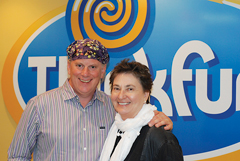 Bill Ritchie and Andrea Barthello, the brains behind the Alexandria-based company ThinkFun, strive to make games that build on children’s innate curiosities and foster growth and creativity. A few of the company’s most popular games include Zingo and, my children’s personal favorite, Rush Hour.
Bill Ritchie and Andrea Barthello, the brains behind the Alexandria-based company ThinkFun, strive to make games that build on children’s innate curiosities and foster growth and creativity. A few of the company’s most popular games include Zingo and, my children’s personal favorite, Rush Hour.
As the parents of two now-grown boys, the co-founders believe games should be an interactive experience between parent and child. “When we started our company,” Bill said, “we had a mission – to bring the wackiest, most creative people together and make their ideas and creations available to all the boys and girls of the world. Anytime we are looking at a toy or game, we are looking for the essence of that game and how it is able to provide inspiration, engagement and help grow children in all of areas of learning development.“ Bill and Andrea have had over thirty years of experience with trying to figure out how their games can be a fun-filled family experience.
“Many of the games we all played growing up were not as purposeful for parents,” notes Andrea. “Going up a ladder and then coming back down does not actively engage a parent.” The focus at ThinkFun is to make games that will create positive family experiences without boring the heck out of parents. Bill says he wants parents to remember to be present and encouraging with their children, “but we as game and toy manufacturers feel we have an important responsibility that when parents and kids are given better tools, their experience together can be a more rich, robust, imaginative, and encouraging experience.”
That said, the next time your little one asks you to play cars or Pretty, Pretty Princess with them for the umpteenth time, try and make an effort to give them your undivided attention. I have to put my phone in a drawer sometimes (really!) to block the distractions when my two ask me to play with them. But boy do their eyes light up when I grab the LEGO characters and start imagining right along with them. Get down on the floor with your kids and play a board game or build a tower or style a doll’s hair. Remember they are learning as they are playing – and you might learn something as well.


